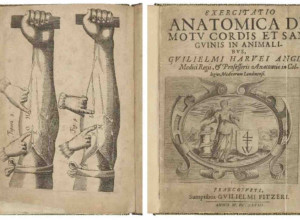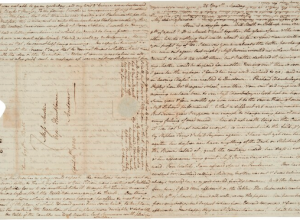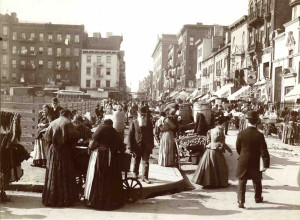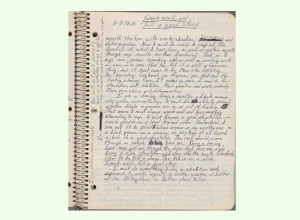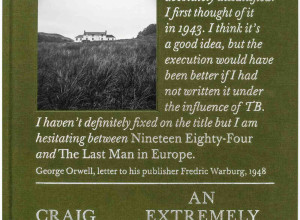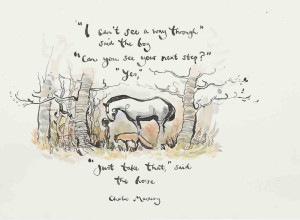December 8, 2013 |
LC Authenticity Symposium: A Brief Report
I confess, I was utterly delighted when I heard that the Authenticity of Print Materials Symposium at the Library of Congress on 6 December had attracted such a large audience that it had to be moved to a larger room. More than 200 people from across the biblio-community were in attendance on Friday for the one-day event, organized by the Library's Rare Book and Special Collections Division.
Following brief welcoming remarks by Mark Dimunation, Chief of the Rare Books and Special Collections Division, the morning session led off with three talks on the authenticity of paper. Tim Barrett, Director of the Center for the Book at the University of Iowa and a 2009 MacArthur Fellow, led off with a talk on the "Authenticity and Authentication of 15th Century European Papers." Barrett discussed his research into what makes so many 15th-century papers particularly durable, beautiful, even "special," the results of which are outlined at the Paper Through Time site. In short, Barrett and his team found that pre-1500 papers contained higher concentrations of calcium and gelatin, and also tended to be both thicker and lighter in color than later papers. These characteristics, combined with typical sheet sizes, suggested to Barrett that papermakers of this period were working to mimic parchment.
Barrett discussed his current efforts to replicate historical paper-making production rates at the University of Iowa, a process documented in the 11-minute film Chancery Papermaking. Tim reported that the team isn't yet satisfied with their results, but that "the effort has already been revealing. Our respect for early artisans and the high-production, skilled work they accomplished has only deepened." And his research into the composition of early paper is ongoing: he said that he hopes that with new technologies and other advances, that eventually scholars will be able to narrow down papers to individual mills, and that an international paper image database might someday be possible.
In closing, Barrett was the first but not the last speaker of the day to remark that authentication always begins with one's intuition, a sense that something just isn't right, and the experiential knowledge to know that's the case. Finally, Barrett asked just why it is that we care about authenticity in the first place, suggesting that we care, at least in part, because an authentic physical object "directly connects us to a human record we can be proud of."
Kim Schenck, the Head of Paper Conservation at the National Gallery of Art, followed Barrett with a discussion of "Assessing Quality in Prints and Drawings." She discussed particularly the practice of misrepresenting facsimile prints as the real thing, which sometimes involves obscuring evidence of the facsimile or even in one case "carving" a fake watermark into a sheet of paper. Schenck also touched on the ways in which conservators look for evidence of prior "restoration" work, sometimes done innocently and performed at other times with intent to deceive. And she discussed changing conservatorial techniques, which at one time frequently included "overpainting" to enhance previously-damaged areas of an artwork, which used to be a common practice but has now fallen out of use. Schenck concluded with another key takeaway of the symposium: it is very important for conservators and others to share their successes and failures when it comes to questions of authenticity.
Cathleen Baker, Conservation Librarian and Exhibition Conservator at the University of Michigan, rounded out the panel on paper with her talk on "Characteristics Unique to Nineteenth-Century Machine-Made Paper." Baker offered a technical overview of machine-papermaking during the period, with a focus on grain direction and its implications for printing and book-making. Like Barrett, Baker suggested that there is "no substitution for holding a great many books of known provenance and date so you know what the real thing feels like."
The second morning session, and the one which I think had most of the audience at the edge of our seats, was "Authenticating and Deauthenticating the ML Sidereus Nuncius," with panelists Paul Needham of Princeton's Scheide Library and Nick Wilding, Assistant Professor at Georgia State University. Wilding offered an overview of the story of the copy of Galileo's Sidereus Nuncius which surfaced in 2005 and now belongs to the New York bookselling firm Martayan Lan. The copy was the subject of a 2007 work by Horst Bredekamp, and the 2011 study Galileo's O by Bredekamp and Needham, which argued that the copy was Galileo's autograph proof copy. But following 2009 revelations by Owen Gingerich that the illustrations cannot date from February 1610 and thus are a modern forgery, Wilding began to explore the other aspects of the copy (shorthanded throughout as SNML).
Wilding's systematic and dogged investigations eventually revealed that the library stamp on the title page had been faked, and that printing errors threw the contention that this was Galileo's proof copy into serious doubt. Additional work revealed that the title page appeared to be a composite image drawn from at least two different copies, and that the forgery had been created by means of a photopolymer plate technique (which is easily done, but leaves telltale signs behind). You can view Wilding's slides for some excellent examples of the work he did to deauthenticate the SNML, or an overview of Wilding's research.
Paul Needham began his presentation with the simple declaration "Let it be recorded, I was completely wrong." He laid out some of the various things he checked and rechecked in coming to agree with Wilding that the copy was completely forged, including making measurements of the book's inner margins at the center of gatherings and comparing those with known copies, examining evidence of retouching in the supposed proof copy which would not have been possible bibliographically (which he called the "not in this universe" proof, and more.
Wilding and Needham barely had time to discuss the paper and the binding, only noting briefly in response to questions that they've now determined that the paper was also forged and was not old sheets used for this project, and that while the binding's boards were old, the rest of the binding was entirely forged. And there was little time to explore the social context of the forgeries and their purpose, let alone the broader implications (the circle responsible for these seems to have created more forgeries, some of them designed to replace authentic copies stolen from libraries). So there is much more to be learned about these, and I hope Needham and Wilding with both continue their investigations. A forthcoming New Yorker article by Nicholas Schmidle will also discuss the Galileo forgeries and their perpetrator.
The afternoon session, on color, opened with Lynn Brostoff, Senior Research Chemist in the Library of Congress' Preservation Division. She discussed a recent project to analyze the coloration in the Library's copy of a 1513 Ptolemy Geographia, utilizing x-ray fluorescence (XRF) technology to determine inorganic components in the various colors used in the atlas, and to determine why certain maps were suffering more than others from a condition known as verdigris syndrome. Read more on this project in the 2011 paper "Solving the Ptolemy Puzzle."
Thomas Primeau of the Baltimore Museum of Art discussed some methods used to detect contemporary hand-coloring in early printed images. He suggested that certain early prints were made with the expectation that color would be added, and that stencils were often utilized for this purpose. Primeau concluded with some fascinating information about some fragments of stencils used as binder's waste and discovered in a book at the New York Public Library; this example was particularly fascinating because the NYPL offered photographs of the stencil fragments after some of them had already been reconnected, which led Primeau to make entirely inaccurate conclusions about the stencils which were only corrected when he viewed them in person and could see that they'd been reconnected. "Presentation affects perception," he reminded.
Margaret Ford, International Head of Group for Books and Science at Christie's, was the day's final panelist. She offered the auction-house perspective on hand-coloring, noting that coloring has long been seen as a premium feature of books (going back to the Nuremberg Chronicle), and that there was for centuries a clear financial incentive to colorize. Today, though, "coloring up" a book may serve to decrease a book's value, rather than the reverse. Ford noted that it is often difficult to determine when color may have been added to a book, but offered several practical checks for those of us without access to a full-scale conservation lab: the language of the catalog description, evidence offered by the verso of the image and at any folds, knowing the stock and comparing other copies when possible is important. Like other panelists, Ford stressed the importance of consulting other experts in the field for assistance and advice.
That theme would be taken up in turn by the day's keynote speaker, Michael F. Suarez, S.J., the Director of Rare Book School at the University of Virginia. Suarez's began by challenging the very concept of "authenticity," noting the frequent degradation of the term, the danger of using atypical outliers as exemplars (the Hours of Catherine of Cleves, or the Hypnerotomachia Poliphili, he argued, are fascinating works, but severely unrepresentative as examples of books of hours or printed Renaissance texts), and the "gross inauthenticities" sometimes offered up in the name of authenticity. He cited particularly the National Trust's rebuilding of Uppark House after a 1989 fire to look intentionally just like it had immediately preceding the fire, and the British Library's Turning the Pages interface, which offers an experience quite unlike turning the pages actually would.
After pointing out that the early modern music movement eventually abandoned the idea that authenticity could ever actually be achieved, Suarez declared that we should not follow suit. He called for a revival of connoisseurship, defined as interiorized understanding and hard-won knowledge, and for a robust critical bibliography, characterized by the building of cross-disciplinary teams in which both scientific analysis and the profoundly humanistic study of bibliography can combine to help us learn more about the history of human makers and unmakers. By working to become not merely a community of experts, each speaking only to what we know individually, but rather a community of learners, Suarez concluded, we can together recover the human presences which created the books and arts of art we know and love.
The Symposium closed with a tearful tribute by Mark Dimunation to Dan De Simone, who is leaving the Library of Congress to become the Eric Weinmann Librarian at the Folger Shakespeare Library in January. It was a thoroughly interesting and provocative day, and I suspect the conversations sparked by the panels on Friday will lead to much fruitful research and discussion in the future.
The entire symposium will soon be available as a webcast via the Library of Congress; I'll post a link when it's available.
Following brief welcoming remarks by Mark Dimunation, Chief of the Rare Books and Special Collections Division, the morning session led off with three talks on the authenticity of paper. Tim Barrett, Director of the Center for the Book at the University of Iowa and a 2009 MacArthur Fellow, led off with a talk on the "Authenticity and Authentication of 15th Century European Papers." Barrett discussed his research into what makes so many 15th-century papers particularly durable, beautiful, even "special," the results of which are outlined at the Paper Through Time site. In short, Barrett and his team found that pre-1500 papers contained higher concentrations of calcium and gelatin, and also tended to be both thicker and lighter in color than later papers. These characteristics, combined with typical sheet sizes, suggested to Barrett that papermakers of this period were working to mimic parchment.
Barrett discussed his current efforts to replicate historical paper-making production rates at the University of Iowa, a process documented in the 11-minute film Chancery Papermaking. Tim reported that the team isn't yet satisfied with their results, but that "the effort has already been revealing. Our respect for early artisans and the high-production, skilled work they accomplished has only deepened." And his research into the composition of early paper is ongoing: he said that he hopes that with new technologies and other advances, that eventually scholars will be able to narrow down papers to individual mills, and that an international paper image database might someday be possible.
In closing, Barrett was the first but not the last speaker of the day to remark that authentication always begins with one's intuition, a sense that something just isn't right, and the experiential knowledge to know that's the case. Finally, Barrett asked just why it is that we care about authenticity in the first place, suggesting that we care, at least in part, because an authentic physical object "directly connects us to a human record we can be proud of."
Kim Schenck, the Head of Paper Conservation at the National Gallery of Art, followed Barrett with a discussion of "Assessing Quality in Prints and Drawings." She discussed particularly the practice of misrepresenting facsimile prints as the real thing, which sometimes involves obscuring evidence of the facsimile or even in one case "carving" a fake watermark into a sheet of paper. Schenck also touched on the ways in which conservators look for evidence of prior "restoration" work, sometimes done innocently and performed at other times with intent to deceive. And she discussed changing conservatorial techniques, which at one time frequently included "overpainting" to enhance previously-damaged areas of an artwork, which used to be a common practice but has now fallen out of use. Schenck concluded with another key takeaway of the symposium: it is very important for conservators and others to share their successes and failures when it comes to questions of authenticity.
Cathleen Baker, Conservation Librarian and Exhibition Conservator at the University of Michigan, rounded out the panel on paper with her talk on "Characteristics Unique to Nineteenth-Century Machine-Made Paper." Baker offered a technical overview of machine-papermaking during the period, with a focus on grain direction and its implications for printing and book-making. Like Barrett, Baker suggested that there is "no substitution for holding a great many books of known provenance and date so you know what the real thing feels like."
The second morning session, and the one which I think had most of the audience at the edge of our seats, was "Authenticating and Deauthenticating the ML Sidereus Nuncius," with panelists Paul Needham of Princeton's Scheide Library and Nick Wilding, Assistant Professor at Georgia State University. Wilding offered an overview of the story of the copy of Galileo's Sidereus Nuncius which surfaced in 2005 and now belongs to the New York bookselling firm Martayan Lan. The copy was the subject of a 2007 work by Horst Bredekamp, and the 2011 study Galileo's O by Bredekamp and Needham, which argued that the copy was Galileo's autograph proof copy. But following 2009 revelations by Owen Gingerich that the illustrations cannot date from February 1610 and thus are a modern forgery, Wilding began to explore the other aspects of the copy (shorthanded throughout as SNML).
Wilding's systematic and dogged investigations eventually revealed that the library stamp on the title page had been faked, and that printing errors threw the contention that this was Galileo's proof copy into serious doubt. Additional work revealed that the title page appeared to be a composite image drawn from at least two different copies, and that the forgery had been created by means of a photopolymer plate technique (which is easily done, but leaves telltale signs behind). You can view Wilding's slides for some excellent examples of the work he did to deauthenticate the SNML, or an overview of Wilding's research.
Paul Needham began his presentation with the simple declaration "Let it be recorded, I was completely wrong." He laid out some of the various things he checked and rechecked in coming to agree with Wilding that the copy was completely forged, including making measurements of the book's inner margins at the center of gatherings and comparing those with known copies, examining evidence of retouching in the supposed proof copy which would not have been possible bibliographically (which he called the "not in this universe" proof, and more.
Wilding and Needham barely had time to discuss the paper and the binding, only noting briefly in response to questions that they've now determined that the paper was also forged and was not old sheets used for this project, and that while the binding's boards were old, the rest of the binding was entirely forged. And there was little time to explore the social context of the forgeries and their purpose, let alone the broader implications (the circle responsible for these seems to have created more forgeries, some of them designed to replace authentic copies stolen from libraries). So there is much more to be learned about these, and I hope Needham and Wilding with both continue their investigations. A forthcoming New Yorker article by Nicholas Schmidle will also discuss the Galileo forgeries and their perpetrator.
The afternoon session, on color, opened with Lynn Brostoff, Senior Research Chemist in the Library of Congress' Preservation Division. She discussed a recent project to analyze the coloration in the Library's copy of a 1513 Ptolemy Geographia, utilizing x-ray fluorescence (XRF) technology to determine inorganic components in the various colors used in the atlas, and to determine why certain maps were suffering more than others from a condition known as verdigris syndrome. Read more on this project in the 2011 paper "Solving the Ptolemy Puzzle."
Thomas Primeau of the Baltimore Museum of Art discussed some methods used to detect contemporary hand-coloring in early printed images. He suggested that certain early prints were made with the expectation that color would be added, and that stencils were often utilized for this purpose. Primeau concluded with some fascinating information about some fragments of stencils used as binder's waste and discovered in a book at the New York Public Library; this example was particularly fascinating because the NYPL offered photographs of the stencil fragments after some of them had already been reconnected, which led Primeau to make entirely inaccurate conclusions about the stencils which were only corrected when he viewed them in person and could see that they'd been reconnected. "Presentation affects perception," he reminded.
Margaret Ford, International Head of Group for Books and Science at Christie's, was the day's final panelist. She offered the auction-house perspective on hand-coloring, noting that coloring has long been seen as a premium feature of books (going back to the Nuremberg Chronicle), and that there was for centuries a clear financial incentive to colorize. Today, though, "coloring up" a book may serve to decrease a book's value, rather than the reverse. Ford noted that it is often difficult to determine when color may have been added to a book, but offered several practical checks for those of us without access to a full-scale conservation lab: the language of the catalog description, evidence offered by the verso of the image and at any folds, knowing the stock and comparing other copies when possible is important. Like other panelists, Ford stressed the importance of consulting other experts in the field for assistance and advice.
That theme would be taken up in turn by the day's keynote speaker, Michael F. Suarez, S.J., the Director of Rare Book School at the University of Virginia. Suarez's began by challenging the very concept of "authenticity," noting the frequent degradation of the term, the danger of using atypical outliers as exemplars (the Hours of Catherine of Cleves, or the Hypnerotomachia Poliphili, he argued, are fascinating works, but severely unrepresentative as examples of books of hours or printed Renaissance texts), and the "gross inauthenticities" sometimes offered up in the name of authenticity. He cited particularly the National Trust's rebuilding of Uppark House after a 1989 fire to look intentionally just like it had immediately preceding the fire, and the British Library's Turning the Pages interface, which offers an experience quite unlike turning the pages actually would.
After pointing out that the early modern music movement eventually abandoned the idea that authenticity could ever actually be achieved, Suarez declared that we should not follow suit. He called for a revival of connoisseurship, defined as interiorized understanding and hard-won knowledge, and for a robust critical bibliography, characterized by the building of cross-disciplinary teams in which both scientific analysis and the profoundly humanistic study of bibliography can combine to help us learn more about the history of human makers and unmakers. By working to become not merely a community of experts, each speaking only to what we know individually, but rather a community of learners, Suarez concluded, we can together recover the human presences which created the books and arts of art we know and love.
The Symposium closed with a tearful tribute by Mark Dimunation to Dan De Simone, who is leaving the Library of Congress to become the Eric Weinmann Librarian at the Folger Shakespeare Library in January. It was a thoroughly interesting and provocative day, and I suspect the conversations sparked by the panels on Friday will lead to much fruitful research and discussion in the future.
The entire symposium will soon be available as a webcast via the Library of Congress; I'll post a link when it's available.





